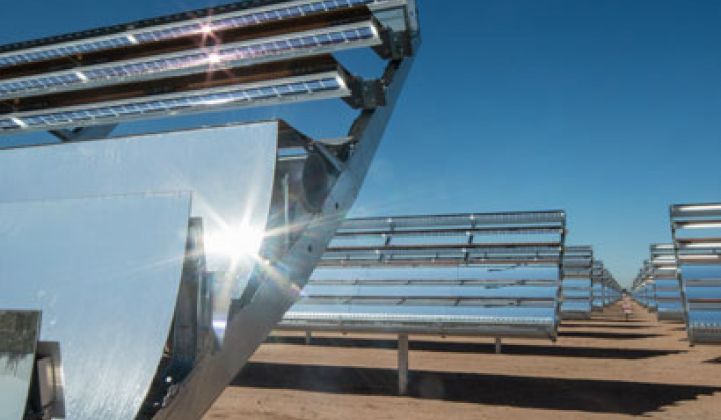Earlier this week, GTM suggested that SunPower is one of the last firms standing in bringing concentrated solar technology to market. That might turn out to be an understatement. What's more, investment firm Baird has suggested that SunPower's "C7 technology is not fully appreciated." That might be changing as well.
SunPower just added several gigawatts' worth of solar projects to its pipeline with a new joint venture in China that will predominantly consist of power plants using the C7 tracker technology. The deal has SunPower investing up to $20 million for a 4.6 percent ownership stake in the venture. Initial deployment of the Sichuan Province-based plants is expected to start next year.
This marks SunPower's second joint venture agreement in China. One of the partners in the current deal is Tianjin Zhonghuan Semiconductor, a producer of monocrystalline silicon, wafers, and semiconductor power devices.
According to SunPower, "To date, a 300-megawatt C7 cell receiver manufacturing facility has been constructed in the Jinqiao Development Zone, Hohhot, Inner Mongolia, and three 50-megawatt production lines are now in operation in connection with the Huaxia joint venture. Last March, SunPower announced the sale of more than 70 megawatts of cell packages to the joint venture. These packages are being used for the first phase of the SunPower LCPV projects, which includes a 20-megawatt project in Saihan and a 100-megawatt project in Wuchuan."
SunPower's low-concentration photovoltaic (LCPV) system combines a single-axis tracker with rows of parabolic mirrors reflecting sunlight onto high-efficiency solar cells.
This morning (evening Sichuan time), GTM asked SunPower CEO Tom Werner why the C7 is seeing such demand in China. He said it is "suited for China's environment, with the "right amount of sunshine." Perhaps more importantly, Werner noted that China is "building way more powerplants...and making long-term investments in a more cost-effective supply chain."
In an earlier interview, Werner noted that while SunPower maintains its IP and ships the high-efficiency silicon receiver assembly, the balance of system (steel, trackers, concrete, etc.) gets sourced and supplied cheaply and appropriately in China.
It's a reach, but perhaps the commodity-intensive nature of an LCPV system is well suited to the Chinese manufacturing chain. But if so, one could still imagine that desert regions of the U.S. would also be suitable for LCPV.
The company claims that its C7 Tracker has up to a 20 percent lower levelized cost of electricity than competing technologies, contending that it provides "the lowest levelized cost of electricity for utility-scale solar power plants available today." SunPower has also said that "a 400-megawatt C7 Tracker power plant requires less than 70 megawatts of SunPower solar cells."
As far as the definition of "pipeline" in that gigawatt-scale claim, Werner said, "We expect most of that to come to fruition in the next five or six years with a high level of probability."
Canaccord Equity Research has upgraded SunPower "on improving solar fundamentals and upcoming positive catalysts," adding, "We expect the company to formally announce or at least provide the framework for another capacity expansion, which we believe can be much larger and faster than the current expansion -- perhaps as much as 1 gigawatt in stages. Without capacity constraints, we could see SunPower growing in line [with] or faster than many of its peers in the future."



